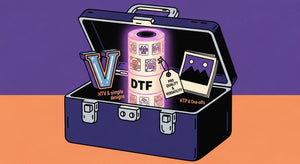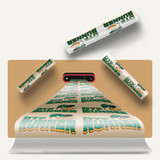Table of Contents
- Understanding DTF Shirt Transfers
- Elements to Consider When Choosing Fabric for DTF Printing
- Best Fabrics Suitable for DTF Shirt Transfers
- Fabrics That Should Be Avoided with DTF Printing
- Preparing the Fabric for DTF Printing
- Tips Toward Perfecting the DTF Shirt Transfers
- Making the Best Choice for Quality Prints
How Critical Is It to Choose the Right Fabric?
The resultant quality, whenever DTF printing is involved, is highly dependent on the type of fabric chosen. Therefore, the right type of fabric should be used for DTF shirt transfers to achieve colorful, detailed, and long-lasting prints. So, we should look for what to consider when choosing fabrics and identify the best options that result in high-quality DTF prints.
Understanding DTF Shirt Transfers
DTF printing is an easy and versatile way to transfer a design onto fabric. It's a process whereby the design is first printed on special film, then adhesive powder is applied to it, after which the heat press presses the design onto the fabric. Intricate designs reveal strong and vivid colors. The success with DTF transfers lies in the type of fabric that is used.

Elements to Consider When Choosing Fabric for DTF Printing
Fabric Composition
The quality of DTF shirt transfers depends on a number of elements within the composition of the fabric. Different fibers have different properties in relation to the look and longevity of the print. Cotton provides for softness and breathability, while polyester will give durability with resistance to shrink. Blended fabrics may combine such properties for balance.
Fabric Weight
The weight of the fabric which is measured in grams per square meter (GSM), affects how well the fabric holds the print. Heavier fabrics generally present a smoother surface for printing and finer images. But, smaller fabrics are lightweight and are very soft on the body, that is very suitable for relaxed wear. Choosing the right fabric weight makes you create the most appropriate DTF shirt transfers.
Fabric Texture
The texture of the fabric may affect the adhesion of the DTF transfer. Smooth fabrics that are weaved tightly provide a perfect surface to which the transfer sticks, thereby prints are sharp and clean. On rough or textured fabrics, the transfer would adhere unevenly and resulting in horrible results. A smooth texture is really important for good results on DTF shirt transfers.
Fabric Color
Another important thing to consider is the color of the fabric. Working with light-colored fabrics are generally easier, since they allow the colors of the DTF transfer to appear more vibrant. Darker fabrics may require the use of a white underbase to make the colors really come out. Which adds an extra step in the printing. Picking the right color of fabric enhances the look of the DTF shirt transfers.
Best Fabrics Suitable for DTF Shirt Transfers
Cotton
Because cotton is so soft and breathable it is one of the most popular fabrics for T-shirt DTF transfers. Additonally, it provides a smooth surface for the transfers which increases the quality of the prints. Besides, cotton is easily available also in varied weights and texture, that makes it the most versatile of all.
Polyester
Polyester is another excellent fabric for DTF printing. It is durable, resistant to shrinking, and holds color well. Polyester fabrics are often used for sportswear and activewear due to their moisture-wicking properties. When using polyester, it's essential to ensure the fabric is smooth and tightly woven for the best results. DTF shirt transfers on polyester can produce vibrant and long-lasting designs.
Cotton-Poly Blends
Blended fabrics, such as cotton-poly blends, combine the best qualities of both fibers. These blends offer the softness of cotton and the durability of polyester, making them ideal for DTF shirt transfers. The combination also allows for greater flexibility in design and application. Cotton-poly blends are especially suitable for creating comfortable and durable garments.
Fabrics That Should Be Avoided with DTF Printing
Rough Textures
One of the general challenges within DTF printing is about fabrics with rough textures, which would include burlap or even canvas. The irregular surface will result in a low-quality print due to poor adhesion of the transfer on the fabric. Such kinds of materials are better avoided for the purpose of DTF transfers. Other smoother fabrics ensure better adhesion and excellent print quality.
Low-Quality Materials
Cheap quality fabrics, imply unsatisfactory print results. These materials can have inconsistent textures or poor dye quality that can affect the transfer's adhesion and appearance. A higher quality fabric ensures better printing outcomes. The materials that you are using are the key to professional DTF shirt transfers.
Preparing the Fabric for DTF Printing
Pre-Washing
Pre-washing your fabric removes any possible chemicals or dirt/oils in the fabric that may cause problems with the transfer. Washing will also prevent any potential shrinkage of fabric after the print has been applied, which means that your design will still be perfect. Pre-washing is a very easy but efficient way to prepare fabrics intended for DTF shirt transfers.
Heat Press Preparation
Gently warm up the fabric before applying the DTF transfer to the garment. This removes excess moisture from the fabric, irons out wrinkles, and provides an even area for the transfer. Proper heat press preparation will ensure there is a good bond between the transfer and the fabric. Making sure the fabric is correctly prepped is one of the most important factors in DTF shirt transfers.

Tips Toward Perfecting the DTF Shirt Transfers
Temperature and Pressure Settings
Choosing the correct temperature and pressure settings on the heat press are very important in quality DTF shirt transfers. An over application of pressure and heat can cause the transfer to smudge or peel, while too little may result in poor adhesion. Always refer back to the manufacturer’s guidelines. Adjusting the settings suited to the type of fabric leads to better transfers.
Avoiding Common Mistakes
Common mistakes in DTF printing include improper fabric preparation, wrong temperature and pressure, and low-quality fabrics. Preparing the fabric by cleaning and smoothening it, ensuring that it is appropriate for DTF transfers, will avoid such issues. Moreover, regular maintenance of the heat press is required, as well as quality transfer materials for the best results. Such mistakes should be avoided so that the DTF shirt transfers remain long-lasting with a brilliant display.
Making the Best Choice for Quality Prints
The proper fabric will directly determine clear, durable, and high-quality DTF shirt transfers. Considering such factors as the composition, weight, texture, and color in fabrics will allow us to use materials most suitable for our DTF projects. Cotton, polyester, and cotton-poly blends are top choices for both printability and longevity. Avoid low-quality, rough textures, and prepare the fabrics properly to come up with exceptional DTF printing results. Follow these guidelines to come up with the best quality DTF shirt transfers you would want for your expectations.






